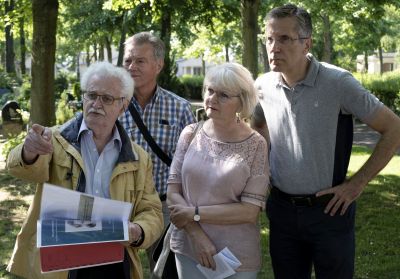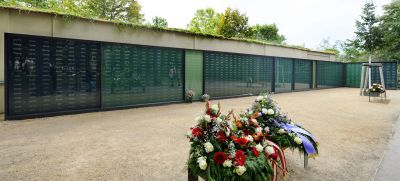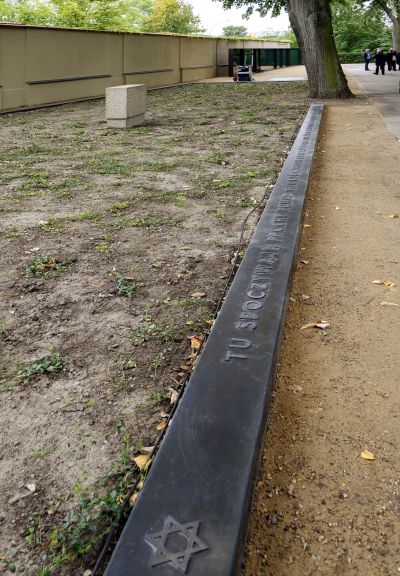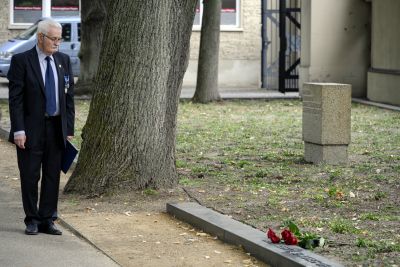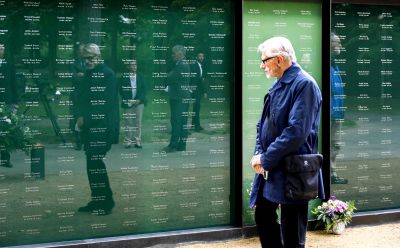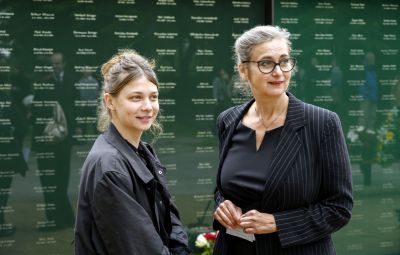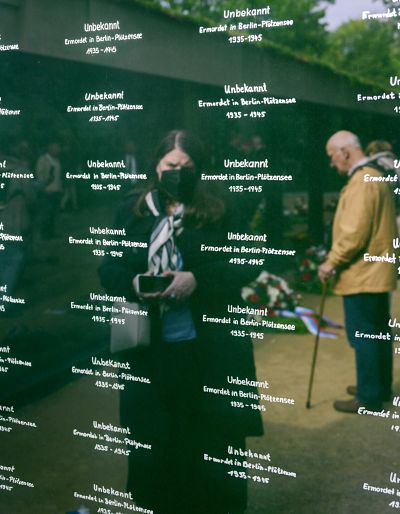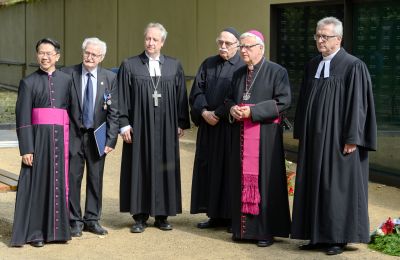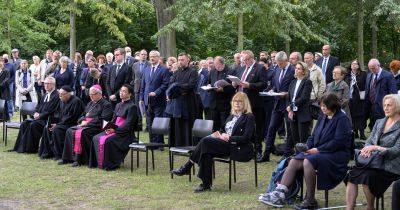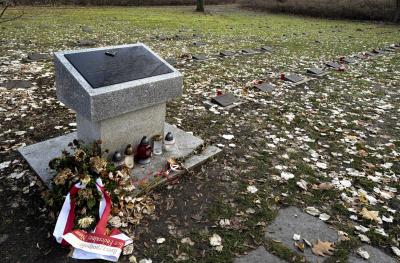REMEMBRANCE BEGINS COLLECTIVELY

It should be remembered that this Berlin necropolis holds a special meaning for us, as it is here that, along with the remains of people of other nationalities, the ashes of 430 Poles were interred - Poles who, from 1939 to 1945, were murdered in the concentration camps and prisons of the Third Reich, including Sachsenhausen and Berlin-Plötzensee.
These victims of Hitler’s reign of terror, more than 1,370 of them, were not just robbed of their lives, they were also “dehumanised” by being interred anonymously and having their memory taken away. The Protestant Bishop Christian Stäblein talked about these “murdered, anonymously buried and dehumanised” [victims] in his sermon.
In his welcoming address, which he directed to guests from Poland, he also made indirect reference to the demands made by Polish groups[1]: “I do not want to conceal the pain that many are feeling because the ashes are buried in the land of the perpetrators. I know why. I can only stand here and say sincerely: We remember, we will never forget those whose ashes lie here. Their individuality, their belief, their names, their heritage, their siblings.”
“Saving them from being forgotten. Giving the dead their identity back. Ripping them out of the vicious circle of anonymity”, that was one of the solutions submitted for the competition advertised by the Berlin Senate in 2018 that Klaus Leutner recalled in our first conversation. For the creators of the winning project, Katharina Struber and Klaus Gruber from the Arbeitsgemeinschaft struber_gruber in Vienna, a living memorial was the main impetus for the redesign of this burial site. With this in mind, they decided to look for a ‘sponsor’ for each person who was buried there. Each of them should then record in their handwriting just the name and dates of birth and death of the deceased. For them, these individual scripts, which will light up brightly in the green glass, represented the heart of the place of remembrance. They chose this form because they believed that it is the people that are alive today who are responsible for commemoration and remembrance. Thanks to the artistic architectural form of the memorial, a place of information and of remembrance was to be created which should also allow the surviving dependents to grieve properly. The realisation of the extraordinary idea was shaped by the fact that many of the next generations were involved.
[1] In my first text for Porta Polonica, I wrote about this and about Mr Woźniak’s role in the discussions about the project to redesign the burial site and about his persistent commitment to exhuming a priest or several priests and to bury them in Poland. It can be found under: https://www.porta-polonica.de/de/atlas-der-erinnerungsorte/das-bewahren-vor-dem-vergessen-der-friedhof-altglienicke-berlin
When he welcomed the guests to the ceremony, Oliver Igel, District Mayor of Treptow-Köpenick, once again highlighted the role of Klaus Leutner and his efforts to rebuild the existing memorial site in the Altglienicke Cemetery. He said: “[He] was the one who did everything (...) to give those who died their identity back. (...) He was tireless (...) and achieved his goal!”
***
But before this humble, yet very moving ceremony could take place, we had to wait three years. Three difficult years, both for the organisers of the competition and for the creators of the memorial.
In all this, it was not just the pandemic that caused delays to the realisation of the project. Technological problems also needed to be solved; there were countless tenders for the glass panels, their frames and the reinforced concrete foundations, but they had to be selected to meet the artistic vision of the authors of the project and, at the same time, ensure that standards were met in terms of the safety of visitors to this place. On top of this, there were problems with the earthworks beyond the burial ground of the murdered victims. Urns from the 1950s were exposed which, for reasons of piety and to comply with statutory provisions, have now been moved to a place specially created for them.[2]
***
Archbishop Dr Heiner Koch opened the interfaith rite with the following words: “This newly created burial ground should be a place for us to remember them and their fate. Along with the 18 Polish priests who are buried here, this fate relates particularly to our Jewish sisters and brothers in faith. They all lived from their faith.”
The Chair of the General Rabbis’ Conference Germany, Prof. Nachama, called for all people to remember “those who died as madness ruled the world and evil lived in the world.” [Also remembered were those] “non-Jewish men and women who had the courage to stand outside the masses and suffer with us. May their sacrifice not have been for nought, may the world draw strength from their death in its daily battle against cruelty and prejudice, against tyranny and persecutions so that we can live together in peace and mutual respect.”
And Claudia Max from the Centre for Democracy, one of more than a thousand volunteer sponsors of the memorial site, stated: “I sponsored the name of one of the anonymous victims because I liked the idea very much that, through my handwriting, I can be a personal part of the memory and because I also personally appreciate the work carried out by Leutner and Struber and Gruber.”
***
For decades, the mortal remains of the nameless victims were at rest in a field along the cemetery wall and, in the style characteristic of the political poetry of East Germany, only a simple stone from the 1950s remembered the “anti-Fascists” buried there.
Today, a glass wall bearing the names of those who died forms the main element of the memorial site, which extends in an L shape from the end of the urn field at the cemetery wall to the south-west border of the necropolis, leaving behind a deep and unique impression.
Depending on the direction and the angle from which the sun’s rays hit the glass wall, so depending on the time of day or year, the names etched in the glass begin to shimmer, they become sharper or, quite the opposite, they meld with the reflections of the cemetery landscape.
[2] Site journal in images at: https://www.erinnerungsort-altglienicke.de/bautagebuch/
As you approach the glass monolith, the writing gets even clearer. It is as unmistakable and as individual as the handwriting of the people who created it and as the fate of all those who stand behind the seemingly insignificant first names and surnames and their dates of birth and death. Suddenly, it becomes clear that this change to the “depth of focus” (sceptics would say that it’s more that the eye starts to accommodate) and the twofold and sometimes even threefold reflection and the coalescence of the vertical areas is no accident; it is exactly how the creators of the memorial intended it to be.
In the monochrome elements of the glass wall that only seem to be opaque, our silhouettes fade into the background behind the lettering of the names of those buried here. If we look through them, we recognise ourselves whilst the feeling creeps up on us that this mirrored chimera would start a dialogue with us, with us from the real world. The fates of those who were murdered, with their names that we do not know and that mean nothing to us, form the bridge of this dialogue.
All those who found their last resting place here are the essence of the dialogue, the link between the actors on both sides of the mirror. Their tragic fate should make us think or even provoke us into thinking. At the same time, we should not just think about who they were and why they had to die; establishing and continuing a dialogue between past and present also means initiating and developing projects that stimulate “remembrance” and “commemoration”.
Above all, what is thought-provoking is how it came to this tragedy and with whose consent it happened.
Perhaps these reflections or mirror images want to remind us that we are the only ones responsible for the freedom in which we live and for protecting it. It is not important whether we have fought for it ourselves or whether it was gifted to us.
At any rate, this is how I understand the intentions of the people who created this memorial.
***
Remembering my compatriots:
Our mantra is to eradicate National Socialism at his roots.
Our goal is to create a new world of peace and freedom.
(“Buchenwald Oath”, 19 April 1945)
***
We will probably never learn about the life stories of the victims buried here. So let us leave them captured between the layers of glass and, - just as the initiator of the project Klaus Leutner wanted it, -let them also be free because their identity and their human dignity have been restored.
This freedom has been gifted to them by the many volunteers who have assumed responsibility by placing their signatures on the glass memorial plate before which we stand. The lettering is as unique and unmistakable as the handwriting of those who wrote it; just like all those who were buried here.
I invite you all to visit the Altglienicke cemetery with this unique memorial.
Wojciech Drozdek, November 2021
A word from me: In my article “Saving them from being forgotten. The Altglienicke Cemetery in Berlin” [3], which I wrote in March 2020 for Porta Polonica, there was a mistake which I would like to correct. It reads: “In urns on a field of remembrance, the ashes of the various persons entered in the cemetery register for areas U1 and U2 may or may not be at rest there (...). The reason for this is easy to understand: In the crematoria in Berlin, as in Sachsenhausen concentration camp later on, several people were all cremated together in a furnace and their ashes were then put in a container.”
However, as Klaus Leutner correctly pointed out, this is not the whole truth. Unlike in the extermination camps that were run by the SS (including Sachsenhausen concentration camp), in the Berlin crematoria, the deceased were cremated individually.
